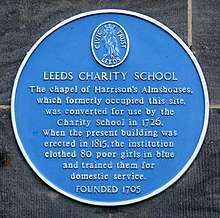Charity school
Charity schools, sometimes called blue coat schools, or simply the Blue School, were significant in the history of education in England. They were built and maintained in various parishes by the voluntary contributions of the inhabitants to teach poor children to read and write, and for other necessary parts of education. They were usually maintained by religious organisations, which provided clothing and education to students freely or at little charge. In most charity schools, children were put out to trades, services, etc., by the same charitable foundation. Some schools were more ambitious than this and sent a few pupils on to university, as depicted in the illustration.

_-_watercolour_-_The_Anniversary_Meeting_of_the_Charity_Children_in_the_Cathedral_of_St._Paul_-_Google_Art_Project.jpg)

Charity schools began in London, and spread throughout most of the urban areas in England and Wales. By 1710, the statistics for charity schools in and around London were as follows: number of schools, 88; boys taught, 2181; girls, 1221; boys put out to apprentices, 967; girls, 407. By the 19th century, English elementary schools were predominantly charity schools.
The establishment, in the nineteenth-century, of a public school system in New York meant that the role of the charity school had come to an end.
Blue coat schools in order of foundation
| School | Date of Foundation | Notes |
|---|---|---|
| Christ's Hospital, Horsham | 1552 | Independent boarding school. The oldest surviving Bluecoat school. |
| Blue Coat Boys' School | 1574 | Housed in the Poor Priest's Hospital in Canterbury, which later became Simon Langton Grammar School for Boys and Simon Langton Girl's Grammar School |
| Queen Elizabeth's Hospital, Clifton, Bristol | 1586 | Also known as The City School |
| Norwich School for Poor Boys, Norwich | 1617 | Also known as the Anguish School, founded by bequest by Thomas Anguish, former mayor of the city. |
| Reading Blue Coat School | 1646 | Secondary school founded by Richard Aldworth. |
| Blue Coat School, Basingstoke | 1646 | Founded by Richard Aldworth. |
| Old Swinford Hospital, Stourbridge | 1667 | |
| The King's Hospital or Blue Coat School, Dublin | 1669 | |
| Greenwich Blue Coat Girls' School | 1700 | A girls' charity school |
| St Mary's School, Banbury | 1705 | A primary school founded as Bluecoat School |
| York Bluecoat School | 1705 | |
| Leeds Charity School | 1705 | [1] |
| Nottingham Bluecoat School | 1706 | A church school |
| Liverpool Blue Coat School | 1708 | A grammar school |
| Nantwich Blue Cap School | <1712 | |
| Tenison's School, Croydon | 1714 | |
| Coventry Blue Coat Church of England School | 1714 | A comprehensive school |
| Stanhope School | 1715 | Merged with the Addey School in 1894 |
| Birmingham Blue Coat School | 1722 | An independent junior prep school |
| Bluecoat Primary School & Nursery, Stamford, Lincolnshire | 18th century | |
| The Blue Coat School, Oldham | 1834 | |
| The Blue Coat School, Dudley | 1869 | Closed in 1989. |
| Bishop of Hereford's Bluecoat School | 1973. | |
| Pilton Bluecoat C of E Primary School | A junior school in Devon |
See also
References
- Higginbotham, P., Leeds Charity School / St John's Home, Leeds, West Riding of Yorkshire, accessed 1 November 2018